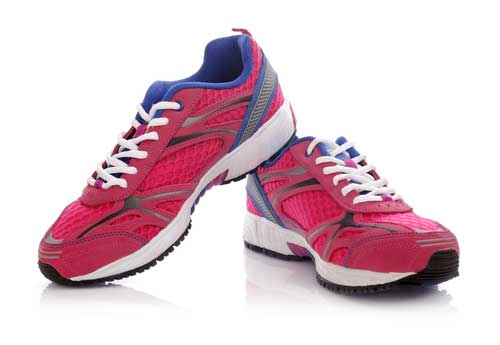These days you have so many choices when it comes to workout shoes. Which ones should you choose? Naturally, you want them to look good but they need to be highly functional too. As with cardio and plyometric workouts, wearing the wrong workout shoes increases your risk for injury. The same goes for weight training. A flimsy pair of workout shoes won’t cut it. That doesn’t mean you have to buy a $100 pair of overpriced workout shoes but there are certain features you should look for in shoes you wear when weight training.
What to Look for in a Weight Training Shoe
Everyone’s feet are a little different. There’s no “one size fits all” when it comes to workout shoes but when it comes to weight training, the shoe you use for your cardiovascular workouts isn’t necessarily the best for weight training. The best workout shoes for plyometric and cardio workouts have soft, compressible soles. These shoes work well because the compressible soles absorb some of the impact when you run and jump.
Workout shoes with compressible soles and lots of cushioning aren’t ideal for weight training because they push your center of gravity forward. When your center of gravity is off, it increases your risk for injury. The optimal workout shoes for weight lifting have a relatively flat heel (an inch or less) and non-compressible soles. A shoe with a flat or low heel is more stable. Plus, when the heel is non-compressible it allows you to generate more force and power since your foot is in closer contact with the floor with no extra cushioning to absorb the force you’re generating. Wearing the right workout shoes can actually increase the amount of weight you lift and reduce your risk for injury by supplying a more stable surface.
Should You Invest in Olympic Weight Training Workout Shoes?
Olympic weight-training workout shoes are equipped with a wooden sole for maximal stability. You don’t really need high-powered Olympic weight-training shoes to maximize your weight-training performance – but make sure the heel is firm and non-compressible. Olympic weight-training workout shoes usually have a half-inch to a one-inch, firm heel. A low heel allows you to go deeper when you squat. These shoes offer maximal stability but are also more expensive.
The Barefoot Shoe Movement
Some weight trainers have jumped on the latest trend – training barefoot. Other daring souls train “au natural” or wear Vibram Five Finger shoes, a minimalist type of shoe with thin soles that conform to the shape of your foot. Wearing minimalist workout shoes or lifting barefoot keeps your heel close to the floor since it’s almost like wearing no shoes. The thickest part of the fabric on a minimalist shoe is only about a centimeter, making it extremely thin. There are some drawbacks. Dropping a weight on your foot doesn’t feel good even if you’re wearing heavily padded shoes but it will feel worse if you’re wearing minimalist workout shoes.
Why did people begin wearing minimalist shoes anyway? They’re popular with runners. The lack of padding encourages a runner to land more on the balls of their feet instead of their heels. This is supposedly more “natural.” Some people also believe walking in them strengthens the muscles in your feet and improves proprioception. Minimalist shoe companies supposedly claimed the shoes have health benefits but haven’t been able to back them up. Interestingly, a 2012 study published in the British Journal of Sports Medicine showed runners who ran in partially minimalist shoes experienced more injuries than those who ran in neutral shoes.
The Bottom Line?
There’s no need to obsess over the type of workout shoes you wear or buy a pair of high-priced Olympic weight-training shoes when you train. Just avoid workout shoes with soft, cushiony, compressible heels and make sure the pair you select fits properly, is comfortable and you enjoy wearing them. If you’ve been training in heavily cushioned running shoes, you may notice a big difference when you switch to workout shoes with a lower and more stable heel. As far as the minimalist shoe movement? You’re better off with a shoe that offers more protection for your foot, just in case you drop a weight.
References:
ExRX.net. “Weightlifting Shoes 101”
Br J Sports Med doi:10.1136/bjsports-2012-092061.
Related Cathe Friedrich Workout DVDs:
All of Cathe’s Strength & Toning Workout DVDs


